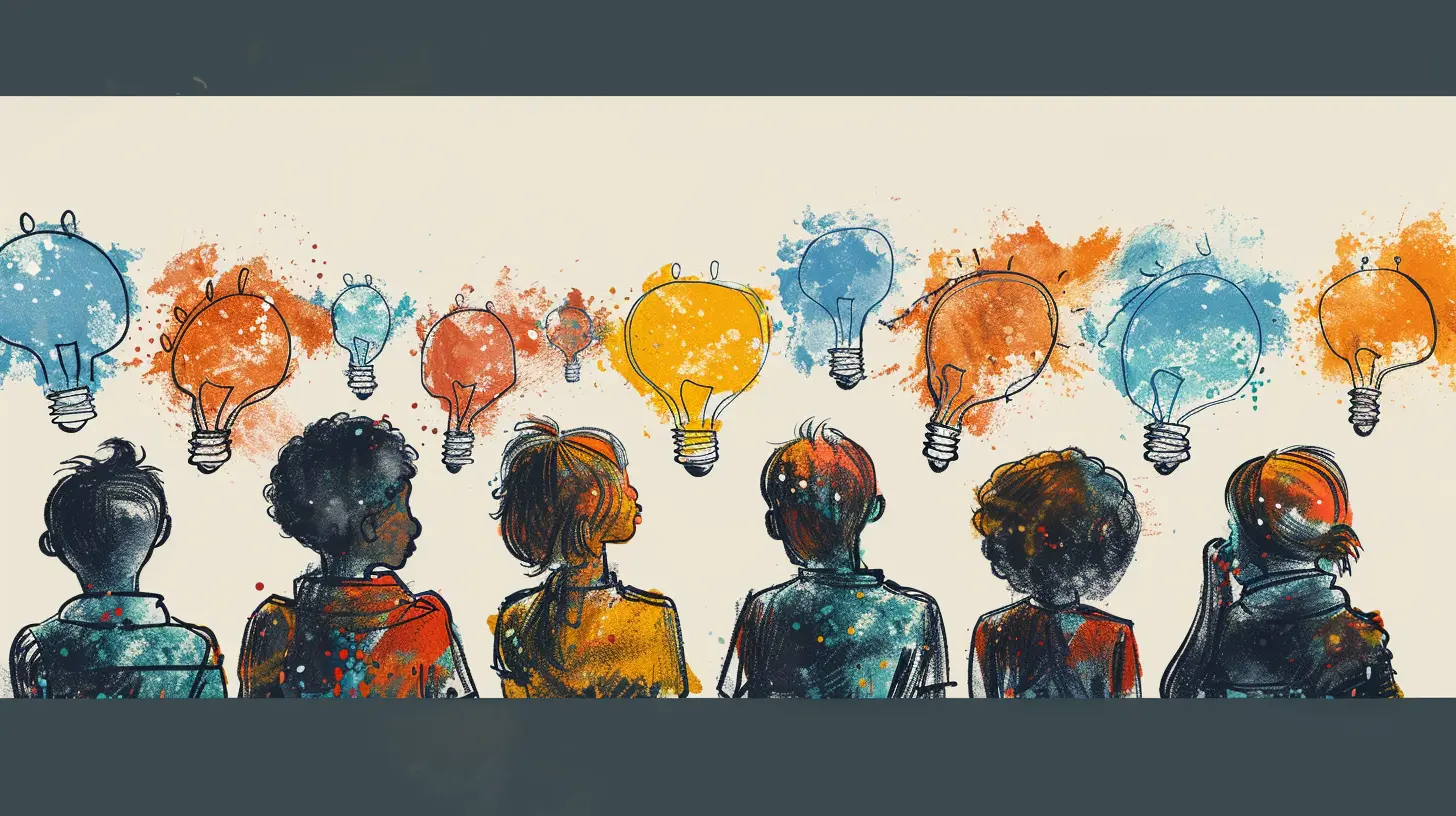How to Integrate Peer Feedback into Formative Assessments
5 June 2025
In the ever-evolving world of education, formative assessments have become essential tools for helping students grow—not just academically, but also in terms of self-awareness and collaborative skills. But here's the thing most people overlook: using peer feedback can totally supercharge those formative assessments.
Sounds simple, right? Student A gives feedback to Student B, and vice versa? In practice, it's a bit more nuanced. There’s an art and strategy to integrating peer feedback effectively so that it’s not just helpful but transformative.
Let’s dive deep into how you can seamlessly weave peer feedback into formative assessments so students don't just learn more—but learn better.
What Is Peer Feedback in Formative Assessment?
Let's start with the basics. Peer feedback is when students provide each other with comments and critiques to help improve their work before final evaluation. Formative assessments are those low-stakes check-ins where the main goal is improvement, not grading.Now imagine combining the two. You’re not just giving students feedback from the teacher’s point of view—you’re putting them in the driver’s seat of their own learning. It's like giving them the cheat codes to level up before the final boss (aka the summative assessment).
When done right, peer feedback can:
- Build critical thinking skills
- Foster a sense of accountability
- Encourage deeper reflection
- Promote collaboration over competition
But here’s where it gets tricky. If students aren’t trained on how to give good feedback, the whole strategy can crash and burn. So let’s talk about making it work.
Why Peer Feedback Matters More Than You Think
Think about it: when you explain something to a friend, don’t you understand it a little better yourself? That’s because teaching—or in this case, giving feedback—reinforces your own learning. Students who engage in peer feedback aren’t just helping others, they're sharpening their own understanding too.Plus, peer feedback offers students more varied perspectives. One teacher, no matter how brilliant, can't see every angle. Classmates often catch things that the teacher misses—or offer suggestions that resonate more deeply, simply because they’re coming from a peer.
And let's be real—sometimes students just feel more comfortable hearing constructive criticism from someone their own age.
Creating a Safe and Supportive Environment
Before we jump into strategies and techniques, let’s tackle a critical first step: trust.If your classroom doesn’t feel like a safe space for kids to be honest and vulnerable, peer feedback won’t work. Period.
Start by:
- Setting clear expectations: Explain why peer feedback matters and how it should be given.
- Making it anonymous (at first): To reduce anxiety, you can have students give feedback anonymously using digital tools like Google Forms or Padlet.
- Modeling it yourself: Show what good feedback looks like. Don’t just say, “Be constructive!” Actually walk through examples of strong and weak feedback.
And always, always emphasize that mistakes are a part of the learning process—not something to feel ashamed of.
Training Students to Give and Receive Feedback
Here’s a little secret: most students don’t automatically know how to give useful feedback. Telling a classmate, “Nice job!” might feel friendly, but it's completely unhelpful.So, how do we teach them? Like anything else—through practice and modeling.
1. Introduce the Feedback Sandwich
It’s exactly what it sounds like: a layer of praise, a layer of critique, and another layer of praise.For example:
- Positive: “Your intro grabs attention right away!”
- Constructive: “You could add a few more statistics to support your argument.”
- Positive: “Overall, your writing voice is really engaging.”
This method keeps the tone kind while still pushing for improvement.
2. Use Checklists and Rubrics
Don’t underestimate the power of a good rubric. When students know what they’re looking for, their feedback gets way better.Share a simplified version of the assessment rubric with students. Focus on criteria like clarity, structure, evidence, creativity—whatever suits the task. When peers have a guide, their feedback is more focused and specific.
3. Practice Active Listening
Feedback isn’t just about giving—it’s about receiving, too. Teach your students how to listen to feedback with an open mind. Encourage them to:- Ask follow-up questions
- Clarify what they don't understand
- Take notes on what they can improve
This makes peer feedback a two-way street, not just a handoff.
Timing is Everything
You’ve heard the phrase “strike while the iron is hot,” right? The same goes for feedback.Peer feedback needs to happen when students still have time to actually revise and improve their work. If you wait until the end of a unit or right before report cards, it’s already too late to make meaningful changes.
Here are a few key moments to integrate peer feedback during formative assessments:
- After drafting and before final submission
- During collaborative group projects
- In the brainstorming or outlining phase
- Post-presentation or performance
Think of it as a pit stop on the learning racetrack—just in time to tune up before the final lap.
Tools and Tech That Make Peer Feedback Easier
Let’s not pretend teachers have endless hours to manage peer review manually. Technology can be your best friend here.Here are some tools that make organizing and tracking peer feedback a breeze:
- Google Docs: Use “suggesting” mode for real-time comments and edits.
- Padlet: Great for anonymous feedback walls.
- Peergrade: Lets students submit work, review peers, and even rate the quality of the feedback.
- Flipgrid: Allows students to leave video feedback—perfect for language learning or presentations.
The right tools can make peer assessment feel less like a chore and more like a classroom conversation.
Making It Stick: Reflecting on the Feedback Process
Once the feedback has been given and received, don’t just move on. Pause. Reflect. Learn from the experience.Have students write short reflection pieces answering questions like:
- What feedback did you receive?
- What changes did you make because of it?
- Was any feedback confusing or unhelpful?
- What did you learn from giving feedback?
This metacognitive moment turns peer feedback from a “task” into a genuine learning opportunity.
Common Pitfalls (and How to Avoid Them)
Let’s be honest—peer feedback doesn’t always go smoothly. Here are some common issues and how to side-step them:Problem 1: Feedback is too vague
Solution: Teach students to be specific and provide examples.Problem 2: Students aren’t taking it seriously
Solution: Make feedback a formal part of the process with clear expectations and accountability.Problem 3: It turns into a popularity contest
Solution: Randomize peer feedback assignments or use anonymous platforms to reduce bias.Problem 4: Feedback overload
Solution: Limit the number of peers students review to 1–3 and keep it focused.Real-Life Classroom Examples
Let’s bring this idea to life with some real-world examples:Example 1: High School English
Students write persuasive essays. After the first draft, they exchange papers with two classmates and leave margin comments focused on thesis clarity and evidence strength. They use a rubric created for the assignment. After feedback, they revise and submit. Teacher also reviews how well students incorporated peer suggestions.Example 2: Middle School Science Project
During a group experiment, each team presents their process and findings. Peers use a checklist to give one plus (what went well) and one delta (what could change). The presenting team then uses that feedback to refine their final report.Example 3: Elementary Art Class
Students share their sketches and perform a “gallery walk” where they write sticky notes with kind and specific feedback. They reflect on what they learned from peers and adjust their final piece.These examples show that peer feedback isn’t just theory—it’s practical, doable, and effective across subjects and ages.
Final Thoughts: It’s a Mindset Shift
When we integrate peer feedback into formative assessments, we’re not just tweaking our teaching strategy—we’re changing the learning culture.Students move from passive recipients to active learners.
They take ownership.
They learn to critique with kindness and accept criticism with grace.
Isn’t that what real learning is all about?
Let’s stop thinking of peer feedback as “extra” and start seeing it as essential. When students help each other grow, they grow together—and that’s the kind of classroom magic that's hard to replicate.
all images in this post were generated using AI tools
Category:
Peer FeedbackAuthor:

Madeleine Newton
Discussion
rate this article
3 comments
Nellie Phillips
This article offers intriguing insights on enhancing formative assessments through peer feedback! I'm curious about the strategies that foster constructive peer interactions and how they can boost student engagement. Looking forward to exploring practical tips that can make peer feedback more effective and impactful in the classroom!
June 22, 2025 at 11:40 AM

Madeleine Newton
Thank you for your interest! We're excited to share practical strategies that encourage constructive peer interactions and enhance student engagement in our article. Stay tuned for effective tips on making peer feedback impactful in the classroom!
Nyxaris Perez
Great insights on integrating peer feedback! It’s heartening to see strategies that foster collaboration and support students’ growth. Empowering learners through each other's perspectives truly enhances their educational journey.
June 8, 2025 at 3:17 AM

Madeleine Newton
Thank you! I'm glad you found the insights valuable. Collaborative feedback is indeed essential for enriching students' learning experiences!
Gabriella Bishop
Empowering students through collaborative growth!
June 7, 2025 at 2:49 AM

Madeleine Newton
Thank you! Collaborative growth through peer feedback is essential for fostering student engagement and enhancing learning outcomes.



